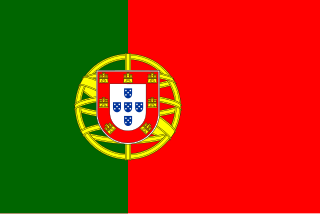Transport in Angola comprises:

Zaire is one of the 18 provinces of Angola. It occupies 40,130 square kilometres (15,490 sq mi) in the north west of the country and had a population of 594,428 inhabitants in 2014. It is bordered on the west by the Atlantic Ocean, on the north by the Democratic Republic of Congo, on the east by the Uíge Province, and on the south by the Bengo Province.

Benguela is a province of Angola, situated in the west of the country. It lies on the Atlantic Ocean, and borders the provinces of Cuanza Sul, Namibe, Huila, and Huambo. The province has an area of 39,826 square kilometres (15,377 sq mi) and its capital is Benguela. According to the 2014 census, there were 2,231,385 inhabitants in the province. The current governor of Benguela is Isaac dos Anjos.

Moçâmedes is a city in southwestern Angola, capital of Namibe Province. The city's current population is 255,000. Founded in 1840 by the Portuguese colonial administration, the city was named Namibe between 1985 and 2016. Moçâmedes has a cool dry climate and desert vegetation, because it is near the Namib Desert.

The Benguela Railway is a Cape gauge railway line that runs through Angola from west to east, being the largest and most important railway line in the country. It also connects to Tenke in the Democratic Republic of the Congo (DRC), and to the Cape to Cairo Railway.

Rail transport in Angola consists of three separate Cape gauge lines that do not connect: the northern Luanda Railway, the central Benguela Railway, and the southern Moçâmedes Railway. The lines each connect the Atlantic coast to the interior of the country. A fourth system once linked Gunza and Gabala but is no longer operational.
The Tripoli–Cape Town Highway or TAH 3 is Trans-African Highway 3 in the transcontinental road network being developed by the United Nations Economic Commission for Africa (UNECA), the African Development Bank (AfDB), and the African Union. The route has a length of 10,808 km (6,716 mi) and has the longest missing links and requires the most new road construction.

Railway stations in Angola include:

Angola is located on the western Atlantic Coast of Southern Africa between Namibia and the Republic of the Congo. It also is bordered by the Democratic Republic of the Congo and Zambia to the east. The country consists of a sparsely watered and somewhat sterile coastal plain extending inland for a distance varying from 50 to 160 km. Slightly inland and parallel to the coast is a belt of hills and mountains and behind those a large plateau. The total land size is 1,246,700 km2 (481,400 sq mi). It has an Exclusive Economic Zone of 518,433 km2 (200,168 sq mi).

In southwestern Africa, Portuguese Angola was a historical colony of the Portuguese Empire (1575–1951), the overseas province Portuguese West Africa of Estado Novo Portugal (1951–1972), and the State of Angola of the Portuguese Empire (1972–1975). It became the independent People's Republic of Angola in 1975.

The history of rail transport in Angola began during the nineteenth century, when Angola was a colony of Portugal. It has involved the construction, operation and destruction of four separate, unconnected, coast-to-inland systems, in two different gauges. Operations on three of those systems have been largely restored; the other system has been closed.

The Port of Lobito is an Angolan port located in the city of Lobito, in the province of Benguela. It is connected to the commercial area of the city and the neighborhood of Canata. It is located in Lobito Bay, which is separated from the Atlantic Ocean by the Lobito Peninsula.

The port of Luanda is an Angolan port located in the city of Luanda, the national capital, in the province of Luanda. It is connected to the city center of Luanda and the district of Ingombota. It is located in the Luanda Bay, which is separated from the Atlantic Ocean by the island of Luanda.

The port of Namibe, or port of Moçâmedes, is an Angolan port located in the city of Moçâmedes, in the province of Namibe. It is built on the banks of the bay of Namibe, a coastal indentation linked to the Atlantic Ocean.
The A8 road is a road in Kenya that spans 923 kilometers. It connects the Ugandan border to the port city of Mombasa, passing through Eldoret and Nairobi. The road is one of the main transportation routes in Kenya, providing an east–west connection. It also serves as a route for international traffic to and from Uganda.
The N101 Road is a national road in Angola located in the exclave of Cabinda. The road runs north south, spanning approximately 150 kilometers from Sanga Mongo to Tando, passing through Dinge. The N101 provides a transportation link within the Cabinda region.
The N105 Road is a national road in Angola spanning 605 kilometers in the southern region. It forms a north–south route, connecting the cities of Benguela, Lubango, and Techiulo. The N105 serves as a transportation link in the southern part of the country, facilitating travel and trade between the key urban centers.
The N110 Road is a national road in Angola connecting Luanda to Xangongo in the south. It's a north–south route that doesn't pass through any major cities besides Luanda and remains partially incomplete and unpaved in large sections. Despite its significance, the road's condition and completion status hinder its full potential as a vital transportation artery.















